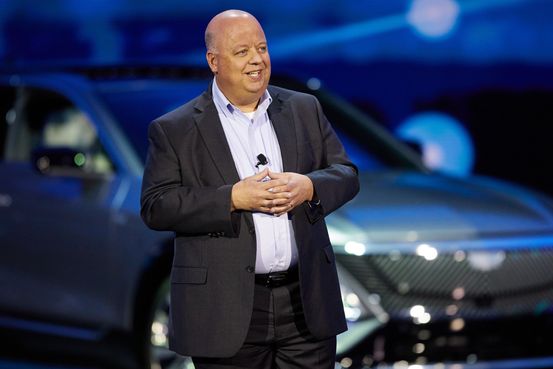
GM is expected to sell 2.4 million vehicles in China this year, which would be a record high for the country. Even with sales reaching such heights, GM CFO says that it will take time before its business becomes profitable again and it plans on posting a long-term plan mid-year.
The “general motors org chart” is a long document that lists all of the different divisions and departments within General Motors.
The finance head of General Motors Co. is aiming to expand the company’s forecasting and planning skills in order to assist the automaker meet its long-term objectives and better explain its business transformation to investors.
The Detroit-based firm announced objectives for 2030 earlier this month that go beyond its standard yearly and five-year targets in the automobile sector. In recent quarters, GM has attempted to demonstrate to investors its transformation into a technology firm that not only makes vehicles but also provides other services such as auto insurance and subscription services, therefore diversifying its income streams.
This Monday, Chief Financial Officer Paul Jacobson remarked, “We’re no longer merely a corporation whose main…or sole profit generator is the selling of a wholesale automobile.”
During an investor event on Oct. 6, the business said that it aims for operating margins of 12 percent to 14 percent by 2030, up from 7.9% last year. The business also said that it expects yearly sales to double to $280 billion, up from an average of around $140 billion over the previous five years. With the support of new battery-powered electric cars, auto-related services, and other associated industries, GM hopes to accomplish these objectives.
Mr. Jacobson said last week, “We felt that it was reasonable to look at the firm on a 10-year trajectory.” “You really don’t convey the complete narrative of where we’re heading from now to the future without that,” he added.
The firm’s business strategy has always been centered on its automotive industry, and has been influenced by the cyclical nature of consumer demand, commodity pricing, and regulation, among other variables, according to the corporation.
Shorter time limits are still used by GM as reference points, such as when it says it expects to deploy 30 plug-in car models worldwide by 2025. Mr. Jacobson said that by 2030, the corporation intends electric cars to account for up to 50% of its sales and that internal combustion engines would be phased out. He claims that the changeover, which is projected to cost billions, would be paid for using monies created domestically. GM has said that it would invest $35 billion on electrified and autonomous technologies between now and 2025.
Mr. Jacobson, who joined GM in December after more than 15 years at Delta Air Lines Inc., including eight as CFO, is looking at new methods to quantify the company’s success. “We’re thinking about the business,” Mr. Jacobson said, “both in terms of what we measure and how we’ll report.”
“‘We’re no longer merely a corporation whose primary…or exclusive source of profit is the selling of a wholesale automobile.’”
— Paul Jacobson, GM’s finance chief
The purpose, according to Mr. Jacobson, is to establish confidence among investors, who will get a “reporting package” detailing the company’s progress toward its objectives.
In recent months, investors have applauded GM’s efforts, pushing up its stock price by about 40% since January. However, with a market value of $82.59 billion, it is still much less than electric competitor Tesla Inc., which has a market capitalization of $861.42 billion. On Tuesday, GM’s stock finished at $56.85, almost unchanged from Monday’s closing.
Mr. Jacobson said that he plans to employ data analytics, artificial intelligence, predictive forecasting, and software bots in the finance sector to automate operations and journal entries. “A lot of the analytics and process automation will free up time for our individual finance staff to be more strategic and forward-thinking,” he added.
The firm, which employs over 4,000 individuals in financial jobs worldwide, intends to teach its staff on how to use these tools.
Subscribe to our newsletter
Journal of the Chief Financial Officer
The CFO Journal team delivers daily news and perspectives on corporate finance in The Morning Ledger.
“I don’t anticipate any significant changes in the financial personnel or headcount as a consequence of this,” he added, “but…the work we’ll be doing in the future will be different than it is now.”
Long-term goals might lead to disappointments owing to cyclical risks and uncertainty over whether customers would purchase electric cars, according to David Whiston, a stock analyst at Morningstar Inc.’s research division. “Forecasting is very tough in any case. Between now and then, a lot may happen, and a lot of it is out of GM’s control,” Mr. Whiston said.
According to Bill Selesky, a senior analyst at Argus Research Co., if GM misses its objective, the stock will be volatile. “The aims they set forth were ambitious and far-reaching.” Mr. Selesky said, “This is a huge stride for them.”
—This article was co-written by Mike Colias.
By 2035, GM intends to phase out virtually all of its gas and diesel cars. The first completely electric Cadillac is leading the charge. Mike Colias of the Wall Street Journal went to a GM testing facility for a ride and an exclusive chat with GM President Mark L. Reuss. Alexander Hotz contributed to this image.
Nina Trentmann can be reached at [email protected].
Dow Jones & Company, Inc. All Rights Reserved. Copyright 2021 Dow Jones & Company, Inc. 87990cbe856818d5eddac44c7b1cdeb8
The “general motors presidents” is a blog post from General Motors CEO Mary Barra about the company’s long-term plans. The blog post was released on May 17, 2017.
Related Tags
- gm executive resolution team
- gm hierarchy
- general motors flowchart
- general motors chief compliance officer
- youngest cfo in the world



